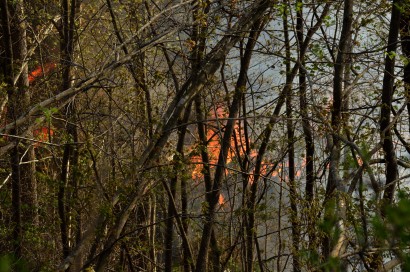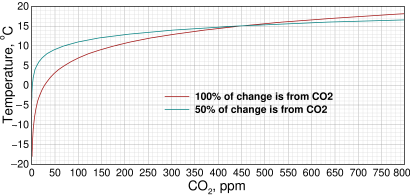 ere's a joke I occasionally tell people: When I was a little kid, we would
get so much snow it was often over my head. Now, it's rarely more than
two feet high. Therefore, it must be global warming.
ere's a joke I occasionally tell people: When I was a little kid, we would
get so much snow it was often over my head. Now, it's rarely more than
two feet high. Therefore, it must be global warming.
Of course, most of my friends are scientists, so they have no sense of humor, and they don't get it. But the joke, as they say, is on them. The global warming war has heated up again, with 1609 scientists signing a statement saying that global warming is not a crisis. As if in response, a new paper in a journal called Energy claims that a billion people— that's 1,000,000,000 humans— are going to die from global warming.
In science, you never base your conclusion on a single technique or a single class of models. You confirm your results with an independent method. This needs to be done with the climate models. A model based on valid scientific principles does not require “tuning.”
In that paper, two academics invent something they call the “1000-ton rule” that claims that one person will die for each thousand tons of fossil carbon that is burned. They base this on the assumption, which seems to have been pulled out of thin air, that every 0.1°C of warming causes 100,000,000 deaths. In the context of seasonal temperature swings of forty degrees (which works out to 40 billion deaths each July), this may seem like a sizable overestimate, but it is evidence of the amount of emotion on this topic.
Some warmers have gone past their Global Boiling Point and are now claiming to be in a state of Extreme Climate Grief, or ECG, which is like a fifth state of matter, but with emotions. And good grief, are they proud of it. An example is this op-ed at Nature mag, which has taken time out from publishing editorials on global warming to publish an op-ed on global warming. It's from a person who claims to be a climate scientist, and she's got the worst case of ECG I've ever seen:
Because of years of ongoing drought, many of the trees would not recover from the long-term water loss and would die. The next morning, I sat outside our science team meeting and cried. A friend sat with me and explained that she had just recovered from an episode of extreme climate grief brought about by studying rapidly changing terrestrial ecosystems.
For just this one year, the blossoming hills gave me a breath of relief amid the ongoing struggle, and I rededicated myself to continuing to fight for everything we can still save.
Even within my lifetime, the climate system has changed noticeably, with hotter summers, longer dry periods and more frequent and severe storms.
If the emotional reasoning in evidence here is representative of the thinking processes of the latest batch of scientists, I grieve for the future of science. Call it extreme science grief or ESG.

Forest fire getting started near my residence. Clear evidence of global warming, or possibly some guy having a problem with his arc welder
What this person is experiencing is not climate change, but a combination of three separate maladies: recency bias, saliency bias, and priming. Maybe she's too young to remember the catastrophic flooding we had in the midwestern USA in 1993 or those severe cold waves we had back in 1983 and 1985. Or even the massive ice storm we had two years ago that knocked out power from Texas to the northern Appalachians.
Recency bias: More recent events are given excess weight and past variations are forgotten. In the 1985 cold wave, Pittsburgh reached −18°F (−28C), the coldest since 1899. Parts of Utah were −69°F, the second coldest temperature ever recorded in the continental US. The 1983 cold wave was even worse: in Chicago the wind chill was −82°F. Where I lived, the wind chill was −60°F. It was so cold that almost everything, including the towing companies, the gas stations, and even the local K-mart, shut down. These events show that extreme temperature changes in both directions are not uncommon.
Saliency bias: If a person experiences something personally, it has a much stronger effect because it's reinforced by multiple sensory modalities. This forces a person to fit it into their pre-existing beliefs. An example is a fire we had this April near my residence (see photo above). Was it global warming or a clumsy neighbor? Or possibly all that dead brush? A warmer would conclude the former; a skeptic would conclude the latter.
Priming bias: If someone predicts a tragedy, people selectively notice evidence that confirms it and ignore evidence that contradicts it. Now we're getting fires not just in my back yard but in Greece, Canada, and Maui. But 97 people in Greece have been arrested for arson. Bureaucrats in Maui may have turned an ordinary brush fire into a massacre by insisting on “true conversations about equity” before they would release any water. A person who was told that fires would occur due to global warming would likely dismiss these confounding factors.
When warmers feed the media with predictions of deadly storms and fires, they prime people to interpret any such news events in terms of anthropogenic global warming. To get clicks, the media induce saliency bias by portraying each event as an unprecedented catastrophe. People have short memories, producing recency bias. Even when it's later shown to be arson, lightning, or incompetence, the claim that global warming is the cause is hammered into our brains.
What does science say
Science tells us that the skeptics who say that 400 parts of CO2 per million is too low to have any effect are mistaken. In fact the opposite is true. Scattering of infrared radiation by carbon dioxide (and any other absorber) follows a logarithmic curve. That means that, as a first approximation, a change of CO2 from 1 to 2 ppm—a doubling of a tiny concentration—causes about the same effect as doubling from 200 to 400 ppm. CO2 levels would have to reach 800 ppm to get another change of the same size. We will all be flying around in fusion-powered cars long before that happens.

Global warming logarithmic curves. The amount of warming a model predicts varies enormously by the assumptions made in constructing the model. All we know for sure is that physics tells us that at 400 ppm the effect of CO2 is nearly saturated
As the graph at right shows, whether it takes a 20% increase or a 200% increase in CO2 to get one degree of warming depends entirely on the assumptions you put into the model. I'll go into the math behind this in a future post, but what this graph really shows is, well, not much except that if you make a bad model you can get any result you want.
The point is that everyone is arguing in a scientific vacuum. When warmers censor dissenting opinions, invent implausible predictions, glue themselves to stationary objects, and vandalize cars because they can't conceive of the possibility that they might be mistaken, it merely makes skeptics more determined to resist. Even less helpful are those people who get all emotional because a tree experienced water loss.
In science, you always confirm your results with an independent method. This is not being done: the entire theory of AGW is based on a single class of computer models. There may be a lot of them, but they're all based on the same assumptions. They also have many flaws that are being concealed from the public, the most serious one being the “tuning” that is done. A model based on valid scientific principles does not require tuning. Because of the enormous impact this issue has on government policy and the economy, it is essential to use an independent method to test whether the models are valid.
One problem is that experimental tests are mostly ruled out because of papers like this one (paywalled), which made so many predictions (all of them speculative and many of them fanciful) that empirical testing is now virtually impossible.
Currently we have a theory that is so inaccurate that one group can casually claim that 1,000,000,000 people will die and another group, with equal justification, can claim that no one will die. This fact, along with the emotionalism, exaggeration, rejection, politicization, and excessive use of adhesives that result, is proof that there is little or no actual science going on here. It's time we got some.
sep 01 2023, 4:42 am. updated sep 02 2023, 4:04 am
